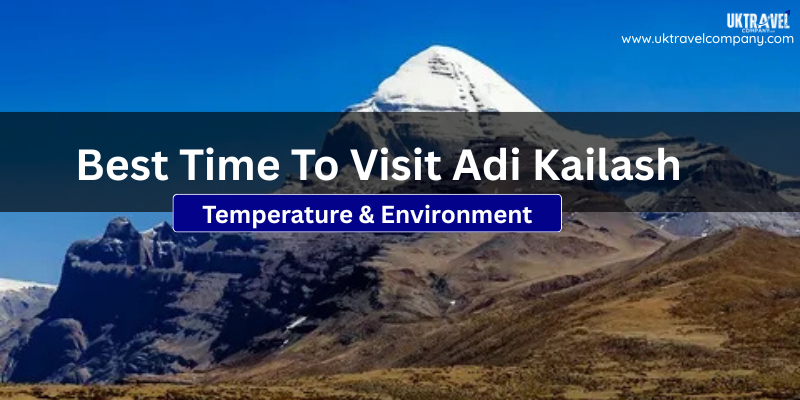Table of Contents
Religious & Spiritual Significance Of Adi Kailash
- Sacred to Lord Shiva: Considered as an abode of the deity Parvati and Lord Shiva.
- Along with Om Parvat, Parvati Sarovar, and Gauri Kund, it is a prominent Hindu pilgrimage site.
Mythological Connections
- Adi Kailash Said to be a place where Lord Shiva meditated.
- It is linked with stories from the Ramayana, Mahabharata, and Puranas.
- Nearby villages (like Kuti) are believed to have been visited by the Pandavas during exile.
Best Time To Visit Adi Kailash & Om Parvat
The ideal time to visit Adi Kailash is between May and October, with the peak months being:
- May to late June
- September to early October.
May- late June are categorized with pleasant weather, lush green valleys as the snow starts melting and roads open for trekking for travellers and for darshan for devotees. Whereas
September- Early October are categorized Scenic beauty, spiritual calm and fewer tourists due to clear skies and cool temperature post monsoon.
Months like July- August should be avoided due to peak monsoon season categorized with landslides and road blockages, Similarly,
late October- April should be avoided due to harsh winter season categorized with heavy snowfall.
Also Read-Safety Tips of Adi Kailash Yatra
Temperature Range Month By Month
| Month | Day Temperature | Night Temperature |
| January | -5 °C to 2 °C | 15 °C to -10 °C |
| February | -3 °C to 3 °C | -12 °C to -8 °C |
| March | 0 °C to 5 °C | -10 °C to -5 °C |
| April | 3 °C to 10 °C | -7 °C to 0 °C |
| May | 8 °C to 15 °C | -2 °C to 5 °C |
| June | 10 °C to 20 °C | 0 °C to 8 °C |
| July | 12 °C to 18 °C | 5 °C to 10 °C |
| August | 12 °C to 18 °C | 5 °C to 10 °C |
| September | 10 °C to 15 °C | 2 °C to 8 °C |
| October | 5 °C to 12 °C | -5 °C to 5 °C |
| November | 0 °C to 8 °C | -10 °C to -2 °C |
| December | -5 °C to 2 °C | -15 °C to -8 °C |
Check out Our :- Adi Kailash Yatra Package
Scenic Beauty & Environment
- Adi Kailash is surrounded by lush green valleys, glaciers, alpine meadows, and snow peaks.
- It is located in a remote, unspoiled region which is ideal for meditation and solitude.
- The Wildlife in this region includes Himalayan birds, mountain goats, and rare flora.
Accessibility & Trekking
- Adi Kailash is accessible via Dharchula, Gunji, and Kuti villages.
- Trekking is now partly replaced by motorable roads, making it easier to reach.
- Border Roads Organisation (BRO) has worked significantly and improved infrastructure for pilgrims and tourists.
Explore Our Adi Kailash Om Parvat Yatra Packages
Travel Tips for Visiting Adi Kailash at the Best Time
- Respect Local Culture & Environment
- Choose the Ideal Season (May–October)
- Carry Layered Clothing
- Stay Hydrated & Acclimatize
- Book Permits & Accommodation Early
- Pack Essentials for Remote Terrain
Conclusion
Adi Kailash, often called Chhota Kailash, stands as a serene and spiritually powerful destination nestled in the Kumaon Himalayas of Uttarakhand. Revered as an earthly abode of Lord Shiva, it attracts pilgrims and trekkers seeking both divine connection and natural beauty. Surrounded by mythological landmarks like Parvati Sarovar and Om Parvat, the region offers an experience steeped in faith, peace, and inspiring landscapes. The best time to visit Adi Kailash is between May and October, with May June and September-early October offering the most favourable weather clear skies, stable roads, and pleasant temperatures. Avoiding the monsoon and winter seasons is essential for a safe and fulfilling journey. An excursion to Adi Kailash is a voyage into the heart of sacred India, where nature, spirituality, and mythology combine in everlasting harmony, whether you’re looking for a spiritual awakening or an exceptional Himalayan adventure.
How is Adi Kailash different from Mount Kailash in Tibet?
Mount Kailash in Tibet is the original Kailash, while Adi Kailash is a spiritually equivalent alternative located in India.
What is the best time to visit Adi Kailash?
May- late June and September- Early October.
How do I reach Adi Kailash?
The journey typically starts from Dharchula in Uttarakhand. From there, you travel through Gunji, Nabi, and Kuti villages, either by road or trekking.
Is any permit required to visit Adi Kailash?
Yes, an Inner Line Permit (ILP) is required, which can be obtained from the SDM office in Dharchula.
Can I visit Om Parvat along with Adi Kailash?
Yes, Om Parvat is usually included in the same pilgrimage route and can be visited during the Adi Kailash Yatra.
Are there accommodations available along the route?
Basic accommodations like homestays, tents, and guesthouses are available.



